
Op-Ed: Why American Universities Must Reopen This Fall
On May 12, the California State University system shocked the world by announcing the continued closure of its 23-campus system through the fall 2020 semester.
As the first campuses to announce such a measure, the Cal State system set a precedent sure to be followed by educational institutions nationwide. Chancellor Tim White credited the prolonged closure of campuses to the ongoing spread of the coronavirus, but has the progression of the virus actually posed sustaining harm to California’s, and America’s, college students?
In reality, California’s population, while hit hard by the virus compared to many other states, failed to meet the harrowing expectations established early on by Gov. Gavin Newsom.
Early in the pandemic, the governor warned that over 25 million Californians could face a COVID-19 diagnosis, but there have only been about 133,000 cases in the state.
Young Americans make up very few confirmed cases, both in California and around the country. In fact, a third of all United States COVID-19 cases are centered in nursing homes, and 80 percent of deaths caused by the virus occur in patients aged 65 or older.
So if the virus isn’t affecting young adults in America to a significant degree, and states like California have successfully flattened the curve to prevent exponential growth in cases of COVID-19, why are our higher education institutions bowing to fear and announcing prolonged closures months in advance?
Other than explaining these decisions through fear-based irrationality, the answer may never be clear. What is clear, however, is the need to reopen America’s college campuses this fall for in-person instruction.
Invisible and sometimes deadly viruses are frightening, and proper precautionary measures should be taken at the discretion of individual Americans, but the most recent COVID-19 data is inconsistent with distance learning for the fall semester.
American college students maintain technology accessibility concerns, psychological challenges and financial hardship from the spring 2019 closure of their campuses, and this reality is not sustainable moving forward.
It is unclear what the majority of universities in the United States plan to announce regarding fall 2020 operations.
The University of California system with its 10 campuses seems to be taking the lead from Cal State, with a spokesperson tentatively declaring at least a partial closure of campuses.
Other institutions, including Purdue University, Creighton University, the University of Notre Dame and the University of Colorado Boulder appear to be intent on reopening campus, even if adjustments might take place in the classroom or in residence halls to encourage social distancing.
In the United States, the college experience is more than just showing up for classes and taking exams; it’s the holistic environment of on-campus community, sporting and social events and the countless opportunities to grow as a whole person and not just as a student.
College is often the launching point for young adults to take responsibility for their lives, to discover new passions and to step into adulthood through internships, networking opportunities and eventually positions in the job market. The lack of on-campus interaction through distance learning fails to provide these same opportunities and stagnates the potential growth of our nation’s next generation.
It’s time for universities to announce the reopening of their campuses for the fall 2020 semester.
The coronavirus mostly affects the elderly, and the success we’ve had in flattening the curve supports this decision. Young adults in our country deserve the chance to grow as whole people in their university communities.
After all, if our nation’s 18-22-year-olds keep taking classes on their iPads or laptops in their childhood bedrooms with little opportunity for personal growth, America is in for a serious failure to launch.
The views expressed in this opinion article are those of their author and are not necessarily either shared or endorsed by the owners of this website. If you are interested in contributing an Op-Ed to The Western Journal, you can learn about our submission guidelines and process here.
Truth and Accuracy
We are committed to truth and accuracy in all of our journalism. Read our editorial standards.
Advertise with The Western Journal and reach millions of highly engaged readers, while supporting our work. Advertise Today.












